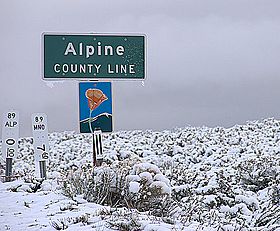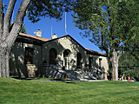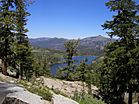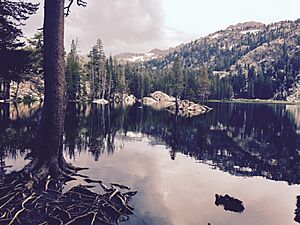Alpine County, California facts for kids
Quick facts for kids
Alpine County, California
|
|||
|---|---|---|---|
| Alpine County |
|||
|
Images, from top down, left to right: an Alpine County line road sign during a snowstorm, Alpine County Courthouse, a view eastward from Carson Pass overlooking Red Lake
|
|||
|
|||
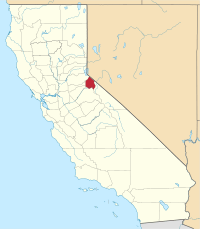
Location in the state of California
|
|||
| Country | |||
| State | |||
| Region | Sierra Nevada | ||
| Incorporated | March 16, 1864 | ||
| Named for | Its location in the Sierra Nevada resembling the (Swiss) Alps | ||
| County seat | Markleeville | ||
| Largest community | Markleeville | ||
| Government | |||
| • Type | Council–CAO | ||
| • Body |
Board of Supervisors
Charles Dobson
Ron Hames Irvin Jim Terry Woodrow David Griffith |
||
| Area | |||
| • Total | 743 sq mi (1,920 km2) | ||
| • Land | 738 sq mi (1,910 km2) | ||
| • Water | 4.8 sq mi (12 km2) | ||
| Highest elevation | 11,464 ft (3,494 m) | ||
| Population
(2020)
|
|||
| • Total | 1,204 | ||
| • Density | 1.6205/sq mi (0.6257/km2) | ||
| GDP | |||
| • Total | $0.117 billion (2022) | ||
| Time zone | UTC−8 (Pacific Standard Time) | ||
| • Summer (DST) | UTC−7 (Pacific Daylight Time) | ||
| Area codes | 209, 530 | ||
| Congressional district | 3rd | ||
| GNIS feature ID | 1675840 | ||
Alpine County is a county in the eastern part of the U.S. state of California located within the Sierra Nevada on the state border with Nevada. As of the 2020 census, the population was 1,204, making it California's least populous county. The county seat and largest community is Markleeville.
Contents
History
The Washoe people, a Great Basin tribe, inhabited the Sierra Nevada on the California–Nevada boundary, with the Hung A Lel Ti band populating the Diamond Valley including what would become Alpine County.
Kit Carson and John C. Frémont were among the first explorers to bring nationwide attention to the Sierra Nevada region in their winter 1844 expedition, though the first known westerners to actually explore the area were Jedediah Smith and Joseph R. Walker. Though gold spurred the infrastructural development of Alpine County, the Comstock Lode found near Virginia City, Nevada and the subsequent silver boom was what triggered Alpine County's growth, even attracting gold miners from neighboring Nevada. This prompted the formation on March 16, 1864, from parts of Amador County, Calaveras County, El Dorado County, Mono County and Tuolumne County. It was named Alpine County due to its resemblance to the Swiss Alps. At its formation, it had a population numbering around 11,000. By 1868, however, the local silver mines had proven unfruitful of replicating the Nevada silver boom and the population fell to about 685 in the 1870 Census, a decline that would steadily continue through the 1950s. Silver Mountain (established as Köngsberg) was designated the county seat following the discovery of silver nearby by Norwegian miners. Markleeville, established by Jacob Markley in 1861 as a 160-acre claim encompassing a bridge and toll station, became the new county seat in 1875. The collapse of the silver industry and closing of mines was finalized with the demonetization of silver in 1873, and Silver Mountain was abandoned by 1886, with most businesses moving to Markleeville.
Following the devastating collapse of the silver industry, the population began quickly declining until the 1950s, falling to an all-time low of 241 in 1930. During this time, its small economy limited the county to serving primarily as a trading center for the local farming and lumber industries, as well as fishing and hunting during the 1930s. Several lots in the county were left vacant.
Alpine County finally managed an economic rebound with the construction of the Bear Valley and Kirkwood ski resorts in the late 1960s, the latter of which is split with Amador County. The population shot up from 484 in 1970 to 1,097 in 1980, a 126.65% increase, and has remained around that level. The three national forests (Eldorado, Humboldt–Toiyabe and Stanislaus) means 96% of the county is owned by the federal government, providing opportunities for economic development and tourism to the skiing resorts as well as historical tourism and outdoor recreation.
Geography
According to the United States Census Bureau, the county has an area of 743 square miles (1,920 km2), of which 738 square miles (1,910 km2) is land and 4.8 square miles (12 km2) (0.7%) is water. The federal government owns about 96% of Alpine County, the highest percentage in California, including three national forests: Eldorado (54,318 acres, or 7.81% of the 695,098-acre total), Stanislaus (119,805 acres, or 13.32% of the 899,427 acre-total) and Humboldt–Toiyabe (233,962 acres, or 3.72% of the 6,290,945 acre-total).
Adjacent counties
- El Dorado County – northwest
- Douglas County, Nevada – northeast
- Mono County – southeast
- Tuolumne County – south
- Calaveras County – southwest
- Amador County – west
National protected areas
- Eldorado National Forest (part)
- Stanislaus National Forest (part)
- Toiyabe National Forest (part)
Demographics
| Historical population | |||
|---|---|---|---|
| Census | Pop. | %± | |
| 1870 | 685 | — | |
| 1880 | 539 | −21.3% | |
| 1890 | 667 | 23.7% | |
| 1900 | 509 | −23.7% | |
| 1910 | 309 | −39.3% | |
| 1920 | 243 | −21.4% | |
| 1930 | 241 | −0.8% | |
| 1940 | 323 | 34.0% | |
| 1950 | 241 | −25.4% | |
| 1960 | 397 | 64.7% | |
| 1970 | 484 | 21.9% | |
| 1980 | 1,097 | 126.7% | |
| 1990 | 1,113 | 1.5% | |
| 2000 | 1,208 | 8.5% | |
| 2010 | 1,175 | −2.7% | |
| 2020 | 1,204 | 2.5% | |
| 2023 (est.) | 1,141 | −2.9% | |
| U.S. Decennial Census 1790–1960 1900–1990 1990–2000 2010 2020 |
|||
2020 census
| Race / Ethnicity (NH = Non-Hispanic) | Pop 2000 | Pop 2010 | Pop 2020 | % 2000 | % 2010 | % 2020 |
|---|---|---|---|---|---|---|
| White alone (NH) | 867 | 852 | 801 | 71.77% | 72.51% | 66.53% |
| Black or African American alone (NH) | 7 | 0 | 10 | 0.58% | 0.00% | 0.83% |
| Native American or Alaska Native alone (NH) | 188 | 210 | 214 | 15.56% | 17.87% | 17.77% |
| Asian alone (NH) | 4 | 7 | 12 | 0.33% | 0.60% | 1.00% |
| Pacific Islander alone (NH) | 1 | 0 | 0 | 0.08% | 0.00% | 0.00% |
| Other Race alone (NH) | 6 | 1 | 7 | 0.50% | 0.09% | 0.58% |
| Mixed Race or Multi-Racial (NH) | 41 | 21 | 76 | 3.39% | 1.79% | 6.31% |
| Hispanic or Latino (any race) | 94 | 84 | 84 | 7.78% | 7.15% | 6.98% |
| Total | 1,208 | 1,175 | 1,204 | 100.00% | 100.00% | 100.00% |
2019 American Community Survey estimates
| Population | ||
|---|---|---|
| Group | Estimate | Percent |
| Total population | 1,039 | |
| Sex | ||
| Group | Estimate | Percent |
| Male | 554 | 53.32% |
| Female | 485 | 46.68% |
| Sex ratio (males per 100 females) | 92.8 | 114.2 |
| Age | ||
| Group | Estimate | Percent |
| Under 5 years | 44 | 4.23% |
| 5 to 9 years | 50 | 4.81% |
| 10 to 14 years | 73 | 7.03% |
| 15 to 19 years | 59 | 5.68% |
| 20 to 24 years | 43 | 4.14% |
| 25 to 29 years | 21 | 2.02% |
| 30 to 34 years | 45 | 4.33% |
| 35 to 39 years | 86 | 8.28% |
| 40 to 44 years | 62 | 5.97% |
| 45 to 49 years | 13 | 1.25% |
| 50 to 54 years | 43 | 4.14% |
| 55 to 59 years | 73 | 7.03% |
| 60 to 64 years | 116 | 11.16% |
| 65 to 69 years | 97 | 9.34% |
| 70 to 74 years | 133 | 12.80% |
| 75 to 79 years | 54 | 5.20% |
| 80 to 84 years | 4 | 0.38% |
| 85 years and over | 23 | 2.21% |
| Median age (years) | 52.2 | |
| Age dependency ratio | 97.2 | |
| Old-age dependency ratio | 59.0 | |
| Child dependency ratio | 38.1 | |
| Race | ||
| Group | Estimate | Percent |
| White | 599 | 57.65% |
| Black or African American | 9 | 0.87% |
| American Indian or Alaska Native | 353 | 33.97% |
| --- Cherokee tribal grouping | 0 | 0.00% |
| --- Chippewa tribal grouping | 0 | 0.00% |
| --- Navajo tribal grouping | 0 | 0.00% |
| --- Sioux tribal grouping | 0 | 0.00% |
| Asian | 10 | 0.96% |
| --- Asian Indian | 0 | 0.00% |
| --- Chinese | 0 | 0.00% |
| --- Filipino | 0 | 0.00% |
| --- Japanese | 0 | 0.00% |
| --- Korean | 0 | 0.00% |
| --- Vietnamese | 5 | 0.48% |
| --- Other Asian | 5 | 0.48% |
| Native Hawaiian and other Pacific Islander | 6 | 0.58% |
| --- Native Hawaiian | 6 | 0.58% |
| --- Guamanian or Chamorro | 0 | 0.00% |
| --- Samoan | 0 | 0.00% |
| --- Other Pacific Islander | 0 | 0.00% |
| Some other race | 9 | 0.87% |
| Two or more races | 53 | 5.10% |
| --- White and Black or African American | 0 | 0.00% |
| --- White and American Indian and Alaska Native | 47 | 4.52% |
| --- White and Asian | 0 | 0.00% |
| --- Black or African American and
American Indian and Alaska Native |
0 | 0.00% |
| Hispanic or Latino and race | ||
| Group | Estimate | Percent |
| Hispanic or Latino | 130 | 12.51% |
| --- Mexican | 116 | 11.16% |
| --- Puerto Rican | 0 | 0.00% |
| --- Cuban | 0 | 0.00% |
| --- Other Hispanic or Latino | 14 | 1.35% |
| Not Hispanic or Latino | 909 | 87.49% |
| --- White | 551 | 53.03% |
| --- Black or African American | 9 | 0.87% |
| --- American Indian and Alaska Native | 314 | 30.22% |
| --- Asian | 10 | 0.96% |
| --- Native Hawaiian and other Pacific Islander | 0 | 0.00% |
| --- Some other race | 0 | 0.00% |
| --- Two or more races | 25 | 2.41% |
| Voting Age Population | ||
| Group | Estimate | Percent |
| Voting Age Population | 815 | 78.44% |
| --- Male | 428 | 41.19% |
| --- Female | 387 | 37.25% |
| Nativity and citizenship status | ||
| Group | Estimate | Percent |
| Native (born in the United States) | 986 | 94.90% |
| --- Born in California | 524 | 50.43% |
| --- Born in other U.S. state | 446 | 42.93% |
| ------ Northeastern state | 65 | 6.26% |
| ------ Midwestern state | 65 | 6.26% |
| ------ Southern state | 41 | 3.95% |
| ------ Western state | 275 | 26.47% |
| --- Native born outside U.S. states | 16 | 1.54% |
| ------ Puerto Rico | 0 | 0.00% |
| ------ U.S. Island Areas | 0 | 0.00% |
| ------ Born abroad of American parents | 16 | 1.54% |
| Foreign Born | 53 | 5.10% |
| --- Naturalized U.S. citizen | 30 | 2.89% |
| ------ Europe | 16 | 1.54% |
| ------ Asia | 14 | 1.35% |
| ------ Africa | 0 | 0.00% |
| ------ Oceania | 0 | 0.00% |
| ------ Latin America | 0 | 0.00% |
| ------ Northern America | 0 | 0.00% |
| --- Not a U.S. citizen | 23 | 2.21% |
| ------ Europe | 0 | 0.00% |
| ------ Asia | 5 | 0.48% |
| ------ Africa | 0 | 0.00% |
| ------ Oceania | 0 | 0.00% |
| ------ Latin America | 18 | 1.73% |
| ------ Northern America | 0 | 0.00% |
2010 Census
The 2010 United States census reported that Alpine County had a population of 1,175. The racial makeup of Alpine County was 881 (75.0%) White, 0 (0.0%) African American, 240 (20.4%) Native American, 7 (0.6%) Asian, 0 (0.0%) Pacific Islander, 19 (1.6%) from other races, and 28 (2.4%) from two or more races. Hispanic or Latino of any race were 84 persons (7.1%).
| Population reported at 2010 United States census | |||||||||
|---|---|---|---|---|---|---|---|---|---|
|
|
Population |
|
American |
American |
|
Islander |
races |
more races |
or Latino (of any race) |
| Alpine County | 1175 | 881 | 0 | 240 | 7 | 0 | 19 | 28 | 84 |
|
places |
Population |
|
American |
American |
|
Islander |
races |
more races |
or Latino (of any race) |
| Alpine Village | 114 | 91 | 0 | 19 | 1 | 0 | 2 | 1 | 6 |
| Bear Valley | 121 | 119 | 0 | 0 | 1 | 0 | 0 | 1 | 1 |
| Kirkwood‡ | 97 | 94 | 0 | 3 | 0 | 0 | 0 | 0 | 0 |
| Markleeville | 210 | 192 | 0 | 4 | 2 | 0 | 6 | 6 | 11 |
| Mesa Vista | 200 | 178 | 0 | 15 | 2 | 0 | 0 | 5 | 11 |
|
unincorporated areas |
Population |
|
American |
American |
|
Islander |
races |
more races |
or Latino (of any race) |
| All others not CDPs (combined) | 433 | 217 | 0 | 199 | 1 | 0 | 11 | 15 | 51 |
| ‡ – census results for the portion of this CDP in Alpine County | |||||||||
2000
As of the census of 2000, there were 1,208 people, 483 households, and 295 families residing in the county. The population density was 2 people per square mile (0.77 people/km2). There were 1,514 housing units at an average density of 2 units per square mile (0.77 units/km2). The racial makeup of the county was 73.7% White, 0.6% Black or African American, 18.9% Native American, 0.3% Asian, 0.1% Pacific Islander, 1.4% from other races, and 5.1% from two or more races. 7.8% of the population were Hispanic or Latino of any race. 12.1% were of German, 12.1% Irish, 9.3% English, 6.5% American and 5.7% Italian ancestry. 95.0% spoke English, 3.1% Spanish and 2.0% Washo as their first language.
There were 483 households, out of which 25.5% had children under the age of 18 living with them, 43.9% were married couples living together, 11.0% had a female householder with no husband present, and 38.9% were non-families. 27.7% of all households were made up of individuals, and 5.4% had someone living alone who was 65 years of age or older. The average household size was 2.50 and the average family size was 2.96.
In the county, the population was spread out, with 22.8% under the age of 18, 10.4% from 18 to 24, 27.5% from 25 to 44, 29.3% from 45 to 64, and 9.9% who were 65 years of age or older. The median age was 39 years. For every 100 females there were 110.8 males. For every 100 females age 18 and over, there were 117.2 males.
The median income for a household in the county was $41,875, and the median income for a family was $50,250. Males had a median income of $36,544 versus $25,800 for females. The per capita income for the county was $24,431. About 12.0% of families and 19.5% of the population were below the poverty line, including 27.4% of those under age 18 and 10.1% of those age 65 or over.
Transportation
Major highways
 State Route 4
State Route 4 State Route 88
State Route 88 State Route 89
State Route 89
Airport
Alpine County Airport is a general aviation airport in the Eastern Sierra about 4 miles (6.4 km) from the town of Markleeville. The airport consists of a simple airstrip with an apron for small light aircraft to park. The airport has no buildings, no lights, and is rarely used. The airport is popular with astronomers due to the clear, dark skies.
Communities
All communities in Alpine County are unincorporated:
The only other counties in California with no incorporated cities are Mariposa and Trinity.
Population ranking
The population ranking of the following table is based on the 2020 census of Alpine County.
† county seat
| Rank | City/Town/etc. | Municipal type | Population (2020 census) |
|---|---|---|---|
| 1 | Woodfords Community | AIAN | 225 |
| 2 | Alpine Village | CDP | 224 |
| 3 | Mesa Vista | CDP | 217 |
| 4 | † Markleeville | CDP | 191 |
| 5 | Kirkwood (partially in Amador County) | CDP | 190 |
| 6 | Bear Valley | CDP | 128 |
See also
 In Spanish: Condado de Alpine para niños
In Spanish: Condado de Alpine para niños


